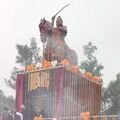Ballabhgarh
For Ballabhgarh in Bharatpur district, please see Ballabhgarh Bharatpur
| Author:Laxman Burdak, IFS (R) |
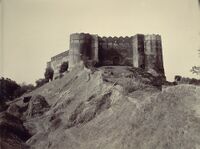
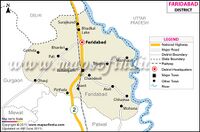
Ballabhgarh (बल्लभगढ़) is a town and tahsil in Faridabad District of Haryana, India.
Raja Nahar Singh (1823 – 1858) was King of this princely state. The forefathers of Jat Raja Nahar Singh had built a fort here around 1739 AD. The small kingdom of Ballabhgarh is only 20 miles from Delhi. The name of the Jat Raja Nahar Singh will always be highly regarded among those who martyred themselves in the 1857 war of independence.
Variants
- Ballabhgarh बल्लभगढ़, जिला फ़रीदाबाद, हरयाणा (AS, p.613)
- Ballamgarh बल्लमगढ़ = Ballabhgarh बल्लभगढ़ (AS, p.613)
- Nizamgarh (See The Jats - Their Role in the Mughal Empire/Chapter IX,p.162)
Origin
Villages in Ballabhgarh Tahsil
Ahmadpur, Akbarpur, Alipur, Aruwah, Atali, Aterna, Auli, Badoli, Badraula, Bahadurpur, Bahbalpur, Bhainsraoli, Bhanakpur, Bhikuka, Bijopur, Bukharpur, Chandaoli, Chandpur, Chhainsa, Dalelgarh, Dayalpur, Digh, Dulahpur Alias Parasrampur, Faizupur Khadar, Fatehpur Biloch, Firozpur Kalan, Garhkhera, Gharora, Ghorasan, Harphala, Hirapur, Imamuddinpur, Jafarpur Majra Chhainsa, Jawan, Junehera, Kabulpur Bangar, Kadhaoli, Kail Gaon, Karnera, Kurali, Ladhauli, Ladhia Pur, Landola, Latifpur, Machhgar, Mahola, Makanpur, Malerna, Mandhawali, Manjhaoli, Maojpur, Mohna, Mortzapur, Mothuka, Mozza Mabad Majra Sekhpur, Mujeri, Mujesar, Nagla Jogian, Nangla Majra Chandpur, Narhaoli, Naryala, Nawada Tigaon, Pahladpur Majra Badrola, Pahladpur Majra Digh, Panehra Kalan, Panehra Khurd, Phophunda, Piyala, Raipur Kalan, Sagarpur, Sahapur Khurd, Sahupura, Samaipur, Sarurpur, Shahjahanpur, Shahpur Kalan, Shahupura, Shekhpur, Sikri, Sikrona, Sotai, Sunper, Zakopur,
Early History
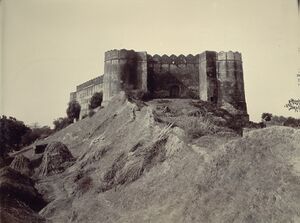
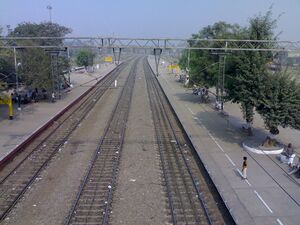
The founders of the princely state of Ballabgarh had come from village Janauli, which is more than 2000 years old. The Tewatia Jat Sardar Gopal Singh left Janauli in 1705 (in Palwal) and got settled at Sihi, a village of Tewatia Jats in Ballabgarh at a distance of about 5 km from Ballabhgarh. The Mughal ruler Aurangzeb had died. Gopal Singh started establishing power in Delhi- Mathura region. With the help of Gujars of village ‘Lagon’ he attacked Rajput Chaudhary of that area and arrived at an agreement with Mugal officer Murtza Khan of Faridabad and became Chaudhary of Faridabad pargana in 1710. He wanted to expand his army and collect huge wealth but died soon. His successor was Charan Das. Charan Das was also ambitious and when saw weakening of the Mughal rule, he stopped paying malgujari. The army of Mughals arrested Charan Das.
Charan Das's son, Balram Singh, later rose to a powerful ruler. Princely state of Ballabgarh is named so after his name. Jats along the Royal Delhi-Agra route at that time were in revolt against the oppressive Mughal rule. Tewatias of this area had already established themselves as counter force in this area. Balram Singh often called Ballu by the local people moved on a few Elephants, Horses and Camels loaded with Big drums (Nagaade) and Dhaunse (big band) followed by his local army. Went wherever Ballu with this band it was assumed that area was no longer of Mughals and Ballu had won that. It was a sort of Aswamedh Yagna that he performed. Here from started a saying "Dheeng Dheeng Ballu ka Raj". Immediately peace returned to those areas, which were conquered by Ballu.
Murtija Khan’s son Akvitmahmud killed Balram Singh on 29 November 1753. After Balram Singh, Maharaja Suraj Mal appointed Balram Singh’s sons Bisan Singh and Kisan Singh as Kiledars. They ruled Ballabhgarh till 1774, when Hira Singh became the ruler of Ballabhgarh.
Raja Nahar Singh ascended the throne in 1829 and proved to be a just ruler. Raja Nahar Singh was ruler of 101 villages of Ballabhgarh.
Ruling Dynasty Tewatia Of Ballabhgarh
Ram Sarup Joon[1] writes that ... Chaudhary Gopal Singh of Sihi began to raid the Moghul territory. Combining with the Gujars he killed the Rajput Chaudhary, The Moghul Governor of Faridabad recognised him as the Chaudhary, but after some time he stopped payment of the revenue to the Royal Treasury, and Chaudhary Charan Das was arrested. His son, Bal Ram made solemn promises to deposit the revenue and had his father released.
But he failed to arrange for the money. Father and son killed Murtaza Khan, the Governor of the Pargana, and took shelter with Raja Suraj Mal, and married his daughter to him. Through his help they sought pardon from Delhi Durbar and finally Bal Ram was reinstated as the Ruler of Ballabgarh.
He was a brave soldier in the forces of Raja Suraj Mal. The last ruler of this dynasty was hanged by the British in 1857.
Suraj Mal helps the Jats of Ballamgarh against the Nawab Wazir Safdar Jang
K. R. Qanungo[2] mentions.... [p.45]: Already master of the Mathura district, Suraj Mal cast his eye upon the neighbourhood of Delhi and was waiting for an oportunity to extend his authority further south. The Jats of Ballamgarh, hard pressed by the faujdar of Faridabad, sought his help, and this embroiled him further with the Mughal Government. We may here briefly trace the history of the Jat feudal house of Ballamgarh. One Gopal Singh Jat of the Tewatia got (sept) settled in Sihi, a village three miles north of Ballamgarh, about 1705 and became wealthy and powerful by highway robbery on the Mathura Delhi road. He allied himself with the Gujars of Tiagaon (8 miles east of Ballamgarh; long. 77°-30', lat. 28°-25'. ) and with their help killed the Rajput Chaudhari of the neighbouring villages. Murtaza Khan the local Mughal officer of Faridabad, instead of punishing the rebel, made peace with him by appointing him as Chaudhari of Faridabad pragana, entitled to a cess (rate) of one anna in the rupee on the revenue in 1710. After the death of Gopal Singh, his son Charandas succeeded him. and seeing how weak the imperial grasp was growing even in the nearer districts, withheld the revenue and set the authority of Murtaza Khan at defiance. However, Charandas was captured and thrown into prison at Faridabad. After some time, his son Balaram, duping1 the Khan by a false payment of ransome, set him at
1. The story goes that Balaram promised to pay a large amount; in cash directly his father was freed. According to previous stipulations, Charandas was brought guarded to the side of a tank near Ballamgarh, and when the cart bringing the treasure had come up, Charandas was let go. He immediately made of on a fleet horse with his son. The other bags were found to contain copper coins (paisa) only. Delhi, Gazetteer, foot note, p. 213.
[p.46]: liberty, Father and son fled to Bharatpur, and securing the aid of Suraj Mal, killed Murtaza Khan (Delhi Gazetteer, p. 213).
This act of rebellious aggression remained unpunished till the accession of Emperor Ahmad Shah (1747). The Wazir wrote repeatedly to Balram and Raja Suraj Mal to give up the above mentioned parganas, but was put off with false pretences and evasive replies. This was sufficient to kindle the wrath of the wazir and to make him swear the utter destruction of the Jats. So he took the field against them in 1162 H. (January, 1749), almost simultaneously with the Amir-ul-umra, and captured Faridabad. Suraj Mal, elated with his recent success over one imperial army led by the commander-in-chief of the Mughal empire, was not in a mood to hear the proposals of the wazir to resign peacefully the places in dispute. He prepared to back the Jats of Sihi with all his resources and putting the forts of Deeg and Kumher in a state of defence, marched against the wazir (June, 1749). Fortune befriended Suraj Mal; the wazir, on receiving the news of formidable Ruhela rebellion in the immediate neighbourhood of his suba of Oudh, had to put off the settlement of his score with the Jats and return to Delhi. He fought these Afghans, and after quelling their disturbance, left his deputy Nawal Ray in charge of the districts wrested from them (beginning of 1750). Then he resumed his operations against the Jats, and sent an army against them. The Jats having got ready for fight, the wazir started against them during the rains (July 1750) and advanced as far as Khizirabad. About this time the news of a great disaster, viz., the defeat and death of Nawal Ray at the hands of Ahmad Khan Bangash, induced the wazir to make up his quarrel with Suraj Mal. A compromise was effected through the mediation of the Maratha vakil. In order to save appearences, Balaram.1 with his wrists bound together,
2. This Balaram is the builder of the fort of Ballamgarh or Ballabgarh. He is not the same man as his namesake, who was the brother of Suraj Mal's wife, Hansia. This Balaram was killed on the 29th November, 1753 by one Aqibat Mahmud Khan as appears from the following entry (p. 83) in the Waqa-i-Shah Alam Sani: "On the 2nd Safar (1167 H.) Aqibat Khan, who went to Ballu Jat (Balaram) to settle the affair of his jagir, had an exchange of harsh words with Jat. He cut off the head of the said Jat and brought his head to His Majesty (Ahmad Shah)." This Aquibat Mahmud was the son of Murtaza Khan, whom Balaram had slain. However, Ballamgarh and Faridabad remained in possession of Suraj Mal who appointed Kishan Singh and Bishan Singh, sons of Balaram, as the quiladar and nazim of Ballamgarh. They retained their office till 1774. (See Delhi Gazetter, p. 213) This date, like all others, in the Gazetteer is doubtful.
[p.47]: accompanied the Maratha envoy to the presence of the wazir, who graciously pardoned him and gave an implicit sanction to his illegal acquisitions. Raja Suraj Mal was given a khilat of 6 pieces, and his bakhshi one of two pieces. Mutual appreciation of merit and ability laid the foundations of a true friendship between the Nawab wazir and the great Jat, who ever after stood faithfully by his ally, even under most desperate circumstances.
Assault On Ballamgarh: 3rd March 1757
Girish Chandra Dwivedi[3] writes.... Ahmad Shah Abdali's Jat Expedition: [p.179]: Hardly had Suraj Mal got relief from the internal crisis, when the Abdali invaded India, (December, 1756). Partly on his own and partly at the supplications of Mughalani Begam, Najib and others, Ahmad Shah Abdali swooped down on the imperil Capital (January, 1757) without meeting any effective resistance on his way. The invaders methodically sacked, tortured and outraged the populace of the Capital. Alamgir was deposed, Imad imprisoned and the Wizarat conferred upon Intizam on his promising to give two crores to the Shah. To escape the Afghan havoc, about half the population of the city flocked to popular refuge, the Jat dominions. However, unlike their earlier behaviour, the Jats this time added to the misery of the refugees by extorting money from them at every post from Badarpur to Mathura. Yet, such a heavy influx continued that getting accommodation became difficult at Mathura.
Girish Chandra Dwivedi[4] writes.... [p.182]: The Abdali now resolved to march in person against the Jat Raja and he sent a foraging party to Faridabad. Jawahar Singh, who was then at Ballamgarh, took 5 to 6 thousand men, fell upon and routed it, slaying some 60 men and capturing 150 horses. This exasperated the Durrani and he ordered Abdus Samd Khan to go out in the night, lie in ambush, despatch 100 sawars to draw out the Jats from their hiding place, and then annihilate them. Abdus Samad literally followed his master. Jawahar Singh narrowly missed falling a victim to the Afghan stratagem. He escaped to Ballamgarh, but a number of his men were killed. The Afghans then attacked and pillaged several Jat villages, killing as many inhabitants as they could. They returned to Faridabad taking the booty and 500 severed heads.
On 22nd February, Ahmad Shah Abdali left Delhi and, moving slowly, came to Faridabad on 26th. At first he ignored nearby Ballamgarh, declaring that his objects were Deeg and Kumher. But the insistence of Imad and the presence of Jawahar Singh there made him change his plans. He personally invested Ballamgarh, despatching (c. 27th February) his vanguard of 20,000 under Jahan Khan and another 20,000 under Najib, with the instructions:
- Move into the boundaries of the accursed Jat, and in every town and district held by him slay and plunder. The city of Mathura is a holy place of the Hindus .... let it be put entirely to the edge of the sword. To the best of your power leave nothing in the Kingdom and country. Upto Akbarabad leave not a single place standing.
Lest the Afghans should fail to execute the command literally he also issued a general order:
To plunder and slay at every place they reached. Any booty they acquired was made a free gift to them. Any person cutting off and bringing in heads of the infidels should throw them down before the tent of the chief minister, wherewith to build a high tower. An account would be drawn up and five Rupees per head would be paid them from government funds.
Assault On Ballamgarh: (3rd March 1757): It was One of the weakest Jat fortifications. The swivel pieces and muskets formed the only fire of this fort against the fire mortars of the Durrani. Besides, Jawahar Singh, who had just returned after having [p.183]: been defeated at Chaumuha, must not have been able to muster up fresh strength. He was unable to hold for long against the enemy fire and he along with the Maratha sardars (Antaji and Shamsher Bahadur) escaped in the darkness of the night (3rd March) dressing as Qizilbashes. The Afghans broke open the gates of the fort and put the remainder to sword. Imad searched in vain corpses after corpses to trace Jawahar Singh. The invaders grabbed 12,000 Rupees, silver and copper utensils, gift idols, 14 horses, 11 camels, grain and clothes in large quantity. The Abdali stayed on for two more days and ordered general massacre and plunder. The environs of Faridabad were desolated and the terror stricken survivors fled elsewhere for safety.
Excerpts from Delhi Gazeeter 1912
See the following link (Page Nos. 222-224)- http://revenueharyana.gov.in/html/gazeteers/Delhi%20Gazeetter%201912.pdf
The name Ballabgarh is probably a corruption from Balramgarh, the fort of Balram, its founder, and the place is by no means an ancient town. The earliest account of its becoming important shows that in 1705 Gopal Singh, a Jat zamindar of the village Alawalpur, came and settled in Sihi near Ballabgarh, having turned out the Taga cultivators of that place. As he waxed strong by plundering travellers on the Muttra road, he was able to attack Amjad, tho Rajput Chaudhri, and, with the aid of the Gujars of Tigtan, to kill him. Murtaza Khan, the local official in Faridabad, tried in 1710 to settle matters by appointing Gopal Singh Chaudhri of the Faridabad Pargana with a cess of one anna in the rupee on the revenue. In 1711 Gopal Singh died and was succeeded by his son Charan Das who, seeing how weak the imperial grasp was growing even in the nearer districts, appropriated the revenue and openly refused to make it over to Murtaza Khan. He was however seized in 1714 and imprisoned by the latter in Faridabad fort where he remained some little time till his Bon Balram, duping the Muhammadan officer under pretence of paying a ransom, set him at liberty.
[The story goes that he promised to pay a large amount in cash directly if his father was freed. To carry out the arrangement, it was stipulated that the captive should be set at liberty directly the silver came into the hands of his captors. He was brought guarded to the side or the tank near Ballabgarh, and when the cart bringing the treasure had come up, and one or two bags of rupees had been examined, Charandas was let go, He immediately made of on a fleet horse with his son. The other bags were found to contain paisa.]
Father and son then obtained the aid of the Bharatpur Raja Surajmal and killed Murtaza Khan. The ascendancy of the Bharatpur Chief continued down to 1738; in-the next year the Delhi King gave the titles of Naib Bakhshi and Rao to Balram and it was to celebrate the acquisition of these honours that Balram built the stone fort-palace of Ballabgarh. He was not annoyed long to enjoy his rank, for he was killed in return for his murder of Murtaza Khan by Akibat Mahmud, the son of his victim. His sons Kishan Singh and Bishan Singh remained in possession of the Ballabgarh Fort and they were in 1762 nominated Kiladar aur Nizam of this parganah by the Maharaja of Bharatpur. In 1774 however he dismissed them from his service and they died about the same time. Next year Ajft Singh, son of Kishan Singh, and Hira Singh, son of Rao Kishan Das, presented themselves before the Emperor at Delhi and agreed to deliver possession of the Ballabgarh parganah to the royal authority: one Najaf Khan of the imperial establishment was deputed to take it. Ajit Singh was appointed Kiladar and Nizam of Ballabgarh while Hira Singh was taken away by the Nawab Najaf Khan to Agra. The next year he came back and Ajit Singh was formally entitled Raja, and Hira Singh was called Haja and also Salar Jang. The revenue of Ballabgarh was estimated at Rs. 1,20,000 and it was made an istamrdr tenure of 60,000 rupees. Meanwhile the administration of the country had come into the hands of Madhoji Scindia who remitted the amount taken as istamrari. In 1793 Ajit Singh was murdered by his brother Zalim, but was succeeded by his son Bahadur Singh. In 1803 on the approach of General Lake, Bahadur Singh sent his son Pirthi Singh and Hira Singh sent his son Ganga Parshad to the English army. Pirthi Singh was killed at the fight at Dara Mukandra, and Ganga Parshad ran away. It appeared that Hira Singh was in collusion with the Mahrattas and so he was turned out of office; Bahadur Singh was confirmed in it in 1804 and received next year the grant of parganas Pall and Pakal in return for undertaking the police arrangements of the road. This Raja built the town of Ballabgarh which is also called Ramganj.
Bahadur Singh having died in 1806, Narayan Singh, his son, succeeded but died also in the same year. Anrud Singh became Raja and ruled till 1818. His minor son Sahib Singh came next and the widow of Anrurd Singh built the Chhatri with a pakka tank in memory of her deceased husband. Sahib Singh died childless in 1825 and was succeeded by his uncle Ram Singh. In the time of this prince the parganahs of Pali and Pakal were resumed by the Government, the Magistrate of Delhi undertaking the charge. Faridabad parganah meanwhile was left in the charge of Ram Singh and he was considered responsible for maintaining the public peace on the Muttra road between the limits of the Burhiya bridge and mauza Pirthala in Palwal. Ram Singh died in 1829 and Nahar Singh, his son, came to power. The earlier years of his reign saw great mischief and intrigue caused by Abhe Ram and Pirthi Singh the ministers, through whose mismanagement the estate fell into debt. In 1839 Abhe Ram was dismissed and Nawal Singh the maternal uncle of Nahar Singh came into power: he ejected Pirthi Singh and in conjunction with Ram Parshad, nephew to Deo Kanwar, became the actual ruler, though all acts continued to be done in the name of Raja Nahar Singh.
In 1840 Nawal Singh becoming absolute, disputes ran high and di-organisation increased, so the British Agent was appealed to and his interference sought.
Enquiries were instituted through a special Commissioner deputed to Ballabgarh and the management of the territory was experimentally entrusted to Kanwar Madho Singh, a grand nephew of Raja Bahadur Singh (the first chief within the time of the British influence), but the plan failed and parganah Interest. Faridabad was taken under British management. The young Raja however protested against this and when he attained his majority and urged his competency to manage his own affairs, the territory was restored to him. Yet, after a long reign, he was implicated in correspondence with the mutineers in 1857 and was hanged. The Raj was confiscated but the dowager Rani Kishan Kanwar was given a pension and allowed to live in Ballabgarh, where she bought the zamindari right from Government for Rs. 64,500. The ownership of the village has since passed into the hands of the Raja of Faridkot.
Ballabgarh is a town of 4,000 inhabitants, 23 miles from Delhi along the Delhi-Muttra Road. It is the headquarters of a tahsil and possesses a thana, school, dispensary, a veterinary dispensary with stallion stables, and a new Town Hall. There is a station on the Agra-Delhi Chord Railway about a mile from the town. The town itself is a collection of mean houses, but has two broad bazars crossing one another at right angles and forming a small square in the centre: from these bazars issue smaller streets but all at right angles to the main bazar with a wall at the end of each: the town is said to have derived its regular shape from having been built on the model of Jaipur. The fort, which is outside the town, contains the palace of the former Raja; it used to consist of several houses of which all, except one, have gone to ruin. There is left only a square two-storied building of white sand stone with carved doors and a courtyard in the centre, which is utilised as a tahsil: outside this is a building now used as a thana. The fort is surrounded by a stone wall about 30 feet high. The town is inhabited mostly by agriculturists and has fallen off in importance since the absorption into British territory.
The municipal income averages Rs. 10,000, Rs. 1,100 is paid in income tax, and the land revenue demand on the agricultural profits amounts to Rs. 3,000, most of which is assigned to the owner, the Raja of Faridkot.
Rani ki Chatri and Shahi Talab, Ballabgarh
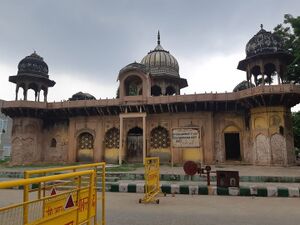
Rani ki Chatri and Shahi Talab, Ballabgarh, Haryana.
The camp of Rani-ki-Chattri includes a pavilion and a stepped tank built by widow of Anuradh Singh, Raja of Ballabgarh till 1818, in Memory of her deceased husband. Rani ki Chattri is a pillared hall baraderi structure with a square plan and elevated plinth. The architectural details include Islamic Multi cusped arches, pointed arches, Braj style Jharokhas capped with bangaldars and central chattri at terrace level with onion dome.The structure is built in bricks and lime, Clad with buff colored sandstone. Interior walls are covered in white araish plaster, the ceiling is painted. Building corners are marked with a octagonal turrets decorated with blind arcades and niches at ground level. Capped with ribbed domed chattris at roof level. A sandstone chajja on decorative stone brackets runs all around the building below parapet level. The tank is composed of Lakhori brick walls with octagonal turrets and arched niches, a style typical of the water body architecture prevalent in the region of North India.
Source - Jat Kshatriya Culture
Ballabgarh Fort
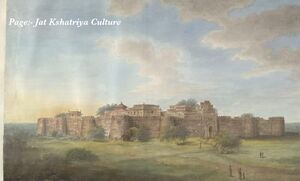
Painting-Ballabgarh Fort(Circa 1815)
Ballabgarh Fort was the capital of Tewatia Jats who ruled over the territory of Modern Faridabad, Palwal and Pali area. Shaheed Raja Nahar Singh of Ballabgarh was made the Prime Minister of the revived Mughal Empire during revolt of 1857. While Bahadur Shah Zafar remained the figurehead Shaheed Raja Nahar Singh led the revolt in Greater Punjab,Delhi and Doab.He stopped the entry of Britishers in Delhi for 4 month and defeated them in numerous struggles.He was captured by Britishers (on part of treachery) and hanged at Chandi Chowk,Delhi.The State was disbanded and the fort of Ballabgarh dismantled.
Source - Jat Kshatriya Culture
Murder of Balram
G.C.Dwivedi[5] writes......[p.161]: The departure of the Jat Vakil to Jaipur almost coincided with the commencement of Imad-Maratha offensive in Mewat. On 26th November, 1753 (29th Muharram, 1167 A.H.), Imad sen this chief agent, Aqibat Mahmud Khan, with 500 Badakhshi and 20000 Maratha soldiers to reconquer Faridabad, which was in his Jagubut had been in Balram's occupation for some time. On being demanded revenue and tribute, Balram became ready for a fight. Imad then sent 700 additional troops and 30 pieces of high artillery and rockets. After some resistance Balram decided to submit. Hence, he met Aqibat, presented him asharfis and promised to clear the dues.31 Aqibat sent his men to Suraj Mal also demanding the peshkash due from him but that chief, "pround of his beg forces", ignored him. At the same time, Aqibat found the peasants at Palwal evasive in paying the revenue. They pretended that Balram might demand it again. Santosh Rai, the Qanungo of the place (Who on account of his expulsion by Balram has become his mortal foe) asked Aqibat that unless he killed Balram he would fail to recapture the district. A thanahdar despatched by him to Fatehpur was expelled by the local peasants who stood by Balram.
31. TAH, 89a-90a.
[p.162]: On 29th November 1753 (2nd Safar), Aqibat, therefore, returned to a plain at Ballamgarh and sent for Balram. He arrived along with his one or two sons, his diwan and 250 sawars and foot.32
The authorities differ regarding the manner of Balram's murder. The Court historian says that Aqibat insisted on Balram to pay the promised tribute, saying that Imad had made the peace for him (although it was incorrect) and that Imad was reproaching him for the delay in collections. Balram replied that he had not brought "the money in his pocket" which he had promised to give only after collecting the rent and that if he (Aqibat) wanted to wrest this tract he would have to fight for that. Aqibat got displeased over this reply and heated arguments followed. When Balram put his hand to his sword, the Badakhshis under Aftab Khan fell upon him and killing him along with his son, the diwan and nine others, losing two of their colleagues in the process.33 Sujan Charitra on the other hand says that Aqibat sent his agent to Balram, taking most solemn oaths to lull his suspicion. When the Jat arrived Aqibat spoke "sweet words" but the assassins, hiding close by, fell upon and cut the heads of Balram and his sons.34 Whatever the truth, both these sources agree that Balram's family, fled to Suraj Mal. Aqibat then got hold of the fort along with its artillery, treasures and other goods. The name of Ballamgarh was changed to Nizamgarh and the head of Balu was ordered to be exposed on a pillar near Faridabad, so that it might serve as a deterrent to other rebels. The news of the fall of Balram and his fort made the Wazir "unhappy".35
32. Ibid, 90b-9Ib.
33. TAH., 91b.
34. Sujan, 204.
35. TAH., 91 b-92b, 106b; Also Sujan 205; Dow, Hindostan, II, 324.
बल्लभगढ़
विजयेन्द्र कुमार माथुर[6] ने लेख किया है .....बल्लभगढ़, जिला फ़रीदाबाद, हरयाणा (AS, p.613) में दिल्ली-मथुरा रेलमार्ग पर स्थित है. 18वीं शती में यह स्थान जाटों की राजनीतिक शक्ति का प्रमुख केंद्र हुआ करता था. कहा जाता है कि 1705 ई. के लगभग गोपाल सिंह जाट ने बल्लभगढ़ के निकट सीही ग्राम में बस कर अपनी शक्ति का संचय किया था. उसके प्रभाव के कारण ही फरीदाबाद के मुगल अधिकारी मुर्तजा खां ने उसे फरीदाबाद परगना का चौधरी नियुक्त किया था. बल्लभगढ़ का नामकरण उसके पुत्र बलराम के नाम पर हुआ था. बल्लभगढ़ में जाटों ने एक दुर्ग का निर्माण किया था. भरतपुर-नरेश सूरजमल ने बल्लभगढ़ के जाटों की मुगल सेनाओं के विरुद्ध सहायता की थी. 1757 ई. में अहमद शाह अब्दाली ने बल्लभगढ़ का घेरा डालकर भरतपुर नरेश जवाहर सिंह को छोड़कर भाग जाने पर विवश कर दिया. बल्लभगढ़ से एक मील दूर सीही ग्राम है जिसे महाकवि सूरदास का जन्म स्थान माना जाता है.
बल्लभगढ़ परिचय
बल्लभगढ़ भारत के हरियाणा राज्य के दक्षिण-पूर्वी भाग में स्थित है। यह राजधानी दिल्ली से लगभग 30 कि.मी. की दूरी पर स्थित है। बल्लभगढ़ फ़रीदाबाद ज़िले का प्रमुख शहर और तहसील है, जो दिल्ली-मथुरा रेलमार्ग पर स्थित है। यह भारत के राष्ट्रीय राजधानी क्षेत्र के अंतर्गत आता है। भारतीय इतिहास में बल्लभगढ़ की भी महत्त्वपूर्ण भूमिका रही है। यह क्षेत्र 18वीं शती में जाटों की राजनीतिक शक्ति का प्रमुख केंद्र हुआ करता था।
इतिहास: बल्लभगढ़ रियासत की स्थापना गांव सिही निवासी बलराम सिंह उर्फ बल्लू ने 1606 ई. में की थी। सबसे पहले राजा बल्लू बने। उनकी सातवीं पीढ़ी में नाहर सिंह पैदा हुए। वे 13 वर्ष की आयु में ही राजा बन गए। राजा नाहर बहुत ही बहादुर थे। उनकी सेना में जाट, गुर्जर, राजपूत, सैनी, वाल्मीकि सभी जातियों के सैनिक शामिल थे। भरतपुर नरेश सूरजमल ने बल्लभगढ़ के जाटों की मुग़ल सेनाओं के विरुद्ध सहायता की थी। 1757 ई. में अहमदशाह अब्दाली ने बल्लभगढ़ का घेरा डालकर भरतपुर नरेश जवाहर सिंह को गढ़ छोड़कर भाग जाने पर विवश कर दिया। बल्लभगढ़ से एक मील की दूरी पर सीही ग्राम स्थित है, जिसे महाकवि सूरदास का जन्म-स्थान माना जाता है।
1857 में अंग्रेजी हुकुमत के खिलाफ पूरे देश में अंदर ही अंदर एक आग सुलग रही थी। इसकी शुरूआत मेरठ छावनी से मंगल पांडे, झांसी की रानी लक्ष्मीबाई आदि कर चुके थे। तब सभी राजाओं के सामने एक ही परेशानी थी कि अंग्रेजों से किस राजा के नेतृत्व मे लड़ाई लड़ी जाए। तब सभी ने मुग़लों के अंतिम बादशाह बहादुरशाह ज़फ़र को दिल्ली के राजसिंहासन पर बैठाकर अंग्रेजों के खिलाफ लड़ाई लड़ने का फैसला लिया और दिल्ली के तख्तोताज की सुरक्षा का जिम्मा बल्लभगढ़ के राजा नाहर सिंह, झज्जर के नबाव, बहादुरगढ़ के नबाव को सौंपा गया। राजा नाहर सिंह की बहादुरी को देखते हुए उन्हें बहादुरशाह ज़फ़र का आंतरिक प्रशासक घोषित किया गया। अंग्रेजी सेना को दिल्ली पर हमला करने से पहले राजा नाहर की सेना का सामना करना पड़ा।
नाहर सिंह के नेतृत्व में सेना ने अंग्रेजी सेना को बुरी तरह से परास्त किया। अब अंग्रेज़ भी यह सोचने के लिए मजबूर हो गए कि जब तक राजा नाहर सिंह है, तब तक दिल्ली पर कब्जा करना मुश्किल है। तब अंग्रेजों ने एक चाल चली। वे शांति का संदेश लेकर राजा नाहर के पास आए और उन्होंने बताया कि वे दिल्ली में बादशाह बहादुरशाह ज़फ़र से समझौता करना चाहते हैं। बहादुरशाह ज़फ़र तब तक बात करने के लिए तैयार नहीं थे, जब तक राजा नाहर सिंह इस बातचीत के मौके पर मौजूद न हों। राजा नाहर सिंह अंग्रेजों की चाल को समझ नहीं पाए और वे उनकी चाल में फंस गए। अंग्रेजों ने राजा नाहर को लाल किले में प्रवेश करने के साथ ही बंदी बना लिया। अंग्रेजों ने बहादुरशाह ज़फ़र को भी बंदी बना लिया। राजा नाहर की लोकप्रियता को देखते हुए अंग्रेजों ने उनके खिलाफ पलवल के डाकखाने को लूटने के आरोप में मामला दर्ज किया और इलाहबाद की कोर्ट में मुकदमा चलाया। 9 जनवरी, 1858 को अंग्रेजों ने राजा नाहर सिंह, उनके सेनापति भूरा सिंह, गुलाब सिंह व अन्य को चांदनी चौक के लाल कुआं पर फांसी के फंदे पर लटका दिया।
नाहर सिंह का भूतपूर्व मुख्यमंत्री साहिब सिहं वर्मा ने दिल्ली में हर वर्ष उनका बलिदान दिवस मनाने की घोषणा की थी। उनका बलिदान दिवस दिल्ली में भी मनाया जाता है। हरियाणा के मुख्यमंत्री रहे बंसीलाल ने राजा नाहर सिंह के ऊपर 9 जनवरी, 1997 को दो डाक टिकट जारी किए थे।
संदर्भ: भारतकोश-बल्लभगढ़
बल्लभगढ़ राजवंश
ठाकुर देशराज के अनुसार यह तेवतिया गोत्र के जाटों का राज्य था। देहली गजेटियर से जो इनका हाल मिलता है वह संक्षेप मे इस तरह से है - बल्लबगढ़ से उत्तर की ओर 3 मील के फासले पर सीही नाम का एक ग्राम है। 1705 ई. के लगभग सरदार गोपाल सिंह नाम का एक जाट वीर यहां आकर बसा। औरंगजेब उस समय मर चुका था। उसके पीछे के मुगल-शासक ऐश, आराम और पारस्परिक कलह में नष्ट हो रहे थे। गोपालसिंह ने अपने साथियों के साथ राज्य-स्थापना की भावना से प्रेरित होकर देहली और मथुरा के बीच के प्रदेश में लूटमार आरम्भ कर दी। थोड़े ही समय में बहुत साधन और शक्ति एकत्रित कर ली। उस समय बल्लभगढ़ से 8 मील पूर्व की ओर ‘लागोन’ नाम के गांव में गूजर बड़ा जोर पकड़ रहे थे। इसने उनसे मित्रता कर ली। आस-पास के गांव की चौधरायत एक राजपूत के पास थी। गूजरों की सहायता से उस राजपूत पर चढ़ाई करके गोपालसिंह ने उसे मार डाला और उसके प्रदेश पर अधिकार कर लिया।
फरीदाबाद में उस समय मुगलों की ओर से मुर्तिजा खां ऑफिसर था। उसे चाहिए तो यह था कि गोपालसिंह को दण्ड देता, क्योंकि उसने मुगलों के राजपूत चौधरी को मारकर राज-द्रोही होने का परिचय दिया था। किन्तु उसने भयभीत होकर गोपालसिंह से संधि कर ली और उसे फरीदाबाद के परगने का चौधरी बना दिया। कुल लगान में से एक आना फी रुपये के हिसाब से कटौती का हक भी उसे दे दिया। यह घटना 1710 ई.की है। गोपालसिंह मुगलों की कमजोरी से खूब लाभ उठाना चाहता था। इसलिए सेना की भर्ती और धन भी संग्रह शीघ्रता-पूर्वक करने लगा। किन्तु उसका इरादा पूरा होने से पहले ही मृत्यु हो गई। उसके बाद चरनदास चौधरी बना। यह भी महत्वाकांक्षी था। उसने जब आसपास के जिलों में बादशाही हुकूमत को कमजोर होते देखा तो मालगुजारी देना बन्द कर दिया। मुगलों की ओर से चरनदास के खिलाफ सेना भेजी गई। चूंकि चरनदास की अभी इतनी शक्ति नहीं थी कि वह मुगल सेना का सामना कर सके, इसलिए चरनदास मुगलों द्वारा गिरफ्तार कर लिया गया।
चरनदास के पुत्र बलराम ने जब देखा कि युद्ध द्वारा अपने पिता को छुड़ा लेना कठिन है तो उसने एक चाल चली। वह यह कि मालगुजारी का रुपया देने का वायदा करके अपने बाप चरनदास को मुगल-सैनिकों के पहरे में बल्लभगढ़ में बुलवा दिया। रुपयों की दो थैलियां उनमें दो-एक में तो रुपये, बाकी सब में पैसे भर दिए। चरनदास छोड़ दिया गया और मुगल-सैनिक थैलियां लेकर के प्रस्थान कर गए।
पिता और पुत्र दोनों ने उस समय यही उचित समझा कि बल्लबगढ़ को
जाट इतिहास:ठाकुर देशराज,पृष्ठान्त-719
छोड़कर भरतपुर के महाराज सूरजमल की शरण में चले जाएं। बाद में शाह अहमदशाह के गद्दी पर बैठने के समय तक यानी सन् 1747 ई. तक इन विद्रोहियों से लिखत-पढ़त लगातार जारी रखी, परन्तु हर समय बहानेबाजी से टाल दिया गया। वजीर की क्रोधाग्नि धधकाने और उससे जाटों का सर्वनाश करने की प्रतिज्ञा कराने के लिए यह पर्याप्त था। अतएव सन् 1749 में अमीरुल उमरा के साथ-साथ ही वह उनके विरुद्ध मैदान में आया और फरीदाबाद को अपने काबू में कर लिया। सूरजमल जिसका कि हौंसला, हाल ही में मुगल-सेना के ऊपर जिसका कि सेनापति शहनशाह (साम्राज्य) का कमाण्डर-इन-चीफ स्वयं था, विजय पाने से बहुत कुछ बढ़ गया था, इस क्षे़त्र में वजीर को शान्ति से राज्य कर लेने देने वाला नहीं था। उसने सब तरह से ही जाटों की सहायता करने की तैयारी की। डीग और कुम्हेर के किलों को सुरक्षित करके वजीर के विरुद्ध कूच बोल दिया। भाग्य ने सूरजमल की सहायता की। वजीर अपने सूबे अवध के आसपास ही में रुहेलों के भयंकर विद्रोह का समाचार पाकर जाटों के साथ झगड़ा न करने का फैसला करके ही देहली को वापस चला गया। उसने इन अफगानों से युद्ध किया और उपद्रव को शान्त करने के पश्चात् अपने नाइब नवलराम को उनसे निकाले हुए जिलों का चार्ज देकर जाटों के खिलाफ कार्यवाही को फिर से अपने हाथ में लिया और उनके विरुद्ध एक सेना भेजी। जाटों के युद्ध के लिए तैयारी हो जाने पर वह जुलाई सन् 1750 में बरसात में उनका मुकाबला करने के लिए बढ़ा चला आया। परन्तु इस समय सहतदखां बंगश द्वारा नवलराम के हराए और मारे जाने के समाचार ने उसे सूरजमल के साथ अपना झगड़ा निबटा लेने के लिए बाध्य किया।
मराठा वकील के बीच में पड़ने से सन्धि हुई। बलराम मराठा मन्त्री के साथ-साथ वजीर के सामने गया, जिसने कि उसे क्षमा प्रदान कर उसकी गैर-कानूनी रीति से कब्जा की हुई भूमि आदि को उसी के अधिकार में बने रहने की गुप-चुप आज्ञाएं दीं। राजा सूरजमल को 6 भागों की और उसके बख्शी को एक भाग की खिलअत दी गई।
बलराम को सन् 1753 ई. की 29 नवम्बर को आकवितमहमूद ने इसलिए मरवा डाला कि बलराम ने उसके बाप मुर्तिजाखां को कत्ल किया था। बलराम के मारे जाने के बाद में महाराज सूरजमल ने उनके लड़के विशनसिंह को किशनसिंह का किलेदार और नाजिम बनाया। वे सन् 1774 तक बल्लभगढ़ के कर्ता-धर्ता रहे। उनके बाद हीरासिंह बल्लभगढ़ का मालिक हुआ।
कैथल व उनके सजातीय बन्धुओं के साथ बल्लभगढ़ के राजाओं ने वैवाहिक सम्बन्ध करने के लिए एक सभा भी कराई थी, क्योंकि मांझ के जाट मलोई जाटों को अपने से हेटा समझते थे।
जाट इतिहास:ठाकुर देशराज,पृष्ठान्त-720
बल्लबगढ़ के राजाओं का खिताब राजा का था। अंग्रेजी-राज्य के समय में इनका सूर्यास्त हो गया।
राजा नाहरसिंह तेवतिया प्रतिमा अनावरण समारोह:31.12.2023
राजा नाहर सिंह तेवतिया प्रतिमा अनावरण समारोह दिनांक 31 दिसम्बर 2023. बल्लभगढ़ हरियाणा ।
सन 1857 क्रान्ति के महानायक अमर शहीद राजा नाहर सिंह तेवतिया जी की प्रतिमा का अनावरण आचार्य देवव्रत राज्यपाल गुजरात द्वारा एवं 52 पाल की सरदारी द्वारा उनकी रियासत बल्लभगढ़ हरियाणा में दिनांक 31 दिसम्बर 2023 को किया गया। इस अवसर पर भूतपूर्व मुख्यमंत्री हरियाणा सरकार श्री ओम प्रकाश चौटाला और श्री भूपेन्द्र सिंह हुड्डा भी उपस्थित थे। राजा नाहर सिंह जी के जीवन और उनके संघर्ष को कोटि-कोटि नमन एवं 52 पाल की सरदारी का आभार।
See also
Further reading
- Dilip Singh Ahlawat- “ Jat Viron ka Itihas : 1857 - THE FIRST WAR OF INDIAN INDEPENDENCE
- Thakur Deshraj: Jat Itihas (Hindi), Maharaja Suraj Mal Smarak Shiksha Sansthan, Delhi, 1934, 2nd edition 1992.
Gallery
-
Ballabgarh Fort (Circa 1815)
External links
- http://www.pugmarks.com/nahar/history.htm
- http://f1.grp.yahoofs.com/v1/wKGkRA8n8_u9myWiaCvJEQDqWWF8MHP4RTYKQopRTjx8qNrwFQN_Cz2_fT7afzNHEFLuNjcTB3W3B4ySCcz6ZeFYQg0-TR8/1857warofindependence.doc
- http://groups.yahoo.com/group/JatHistory/
References
- ↑ History of the Jats/Chapter X,p. 176
- ↑ History of the Jats:Dr Kanungo/Raja Suraj Mal, An Ally of Nawab Safdar Jang,pp.45-47
- ↑ The Jats - Their Role in the Mughal Empire/Chapter X,p.179
- ↑ The Jats - Their Role in the Mughal Empire/Chapter X,p.182-183
- ↑ The Jats - Their Role in the Mughal Empire/Chapter IX,pp. 161-162
- ↑ Aitihasik Sthanavali by Vijayendra Kumar Mathur, p.613
Back to Jat Villages
- Jat Villages
- Haryana Tahsils
- Jat History
- Jat Villages in Haryana
- Villages in Faridabad
- Jat Monuments
- Jat Monuments in Haryana
- Jat States
- Jat Martyr Villages
- Jat Forts
- Jat Forts in Haryana
- Jat Forts in Faridabad
- Cities and towns by Jats
- Cities and towns by Jats in Haryana
- Cities and towns by Jats in Faridabad
- General History
- AS
- AS Haryana







